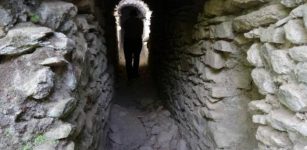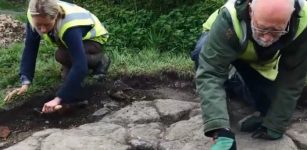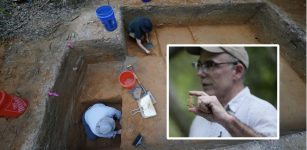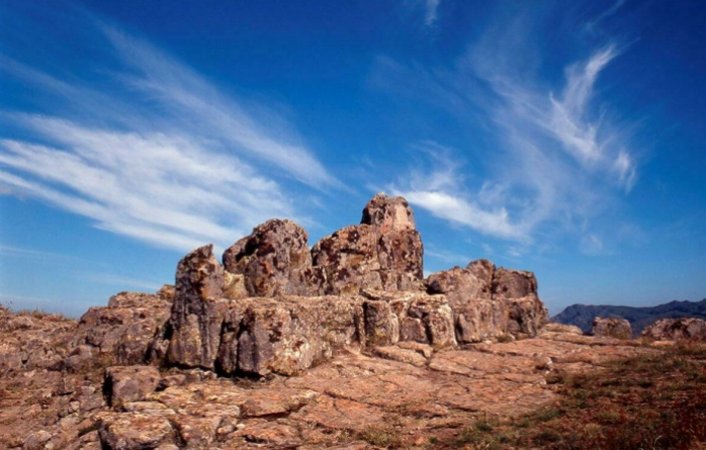4,000-Year-Old Lunar Calendar Developed At Kokino Megalithic Observatory – Evidence Of Remarkable Astronomical Knowledge
Ellen Lloyd - AncientPages.com - All around the world there are magnificent ancient structures that show our ancestors have always been interested in studying the skies. Our interest in the cosmos is as old as humanity. Archaeological discoveries keep reminding us ancient people possessed more astronomical knowledge than previously thought.
Megalithic Observatory Kokino near Kumanovo in Macedonia. Credit: US Government - Public Domain
Several ancient cultures achieved a deep understanding of the celestial movements, cycles of the sun, moon, stars, and planets, and they often used this knowledge to build astronomically oriented temples on the apex of the hills so priests could watch the Sun, the Moon, stars and all planets that could be observed.
There is no doubt fascination with the cosmos was widespread in Egypt, Babylon, Sumer, India, and South America, and we can see proof of this by examining ancient temples, and other sacred structures. However, there is also evidence of ancient less known, yet sophisticated astronomical knowledge in Europe. For example, scientists were stunned when they have discovered the world’s oldest Moon map carved into Ireland’s 5,000-year-old tomb at Knowth.
Equally impressive are the carved-engraved bone plates discovered in France have revealed people created astonishing lunar and solar calendars 30,000 B.C. When and where people started to study the heavens and celestial objects is impossible to say, but if we turn our attention to Europe, we discover extraordinary astronomical knowledge that shows celestial objects were of great importance to our ancestors.
In the Republic of Macedonia, there is an interesting Bronze Age site known as Kokino. Despite being so old, the site was first discovered in 2001 by archeologist Jovica Stankovski.
Locals were most likely familiar with this historical place long before, but the outside world learned about the site only recently.
What makes this particular place so special are the archaeoastronomical characteristics of the megalithic observatory Kokino that is located approximately 30 km from the town of Kumanovo, and about 6 km from the Serbian border, in the Staro Nagoričane municipality.
Scientists have discovered giant stones arranged in puzzling patterns that offer evidence Kokino was used by people as far back as 4,000 years ago.
Kokino is on the foot of a mountain peak, at an elevation of over 3,300 feet. While examining the site scientists found that “on the west side or in on the lower platform of the site there are three specifically crafted observation posts from where the ancient observers continuously monitored the Sun and Moon’s movement. On an about 50 to 85 m distance, in the rocks on the east horizon, which are also placed on the upper platform of the site, there are specially crafted markers, marking the places of the Sun rise and full Moon rise in exactly determined and characteristics days.” 1
Like many other ancient civilizations, people in the Balkans were interested in the Full Moon that is related to numerous ancient myths and legends and even paranormal tales.
Kokino Megalithic Observatory. Credit: Darko Nikolovski - CC BY-SA 3.0
The studies of the Moon at the megalithic Kokino observatory led to the development of a lunar calendar that people used to determine “the moment of switch between the summer and winter and the beginning of the New Year. As in all other cases, the lunar calendar that was developed and used on the megalithic Observatory Kokino had 19 lunar years’ cycle.
About 4,000 years ago people in Macedonia studied the moon and created sophisticated lunar calendars. Credit: Orion 8 - CC BY-SA 3.0
Regular lunar years had a length of 354 days and consisted of 6 lunar months with 29 days and six lunar months with 30 days length. Seven lunar years had thirteen lunar months, due to the fact that according to previously determined scheme one lunar month with 30 days was added. The method of development of the lunar calendar can be demonstrated even today by monitoring the full Moon rise.” 1
The megalithic Kokino observatory adds to the lists of ancient sites demonstrating our ancestors’ profound knowledge of astronomy, and we can once again say ancient people were much more advanced than previously thought. The fact that the method used to develop the lunar calendar at this site 4,000 years ago is still correct is an incredible ancient achievement.
Written by Ellen Lloyd – AncientPages.com
Copyright © AncientPages.com All rights reserved. This material may not be published, broadcast, rewritten or redistributed in whole or part without the express written permission of AncientPages.com
Expand for references- Cenev, G - Three Worlds of the Megalithic Observatory Kokino, Journal: The Inspiration of Astronomical Phenomena VI.
More From Ancient Pages
-
 Remarkable Ancient Statues From The Eye Temple – Unique Legacy From Tell Brak, Syria
Artifacts | Jul 20, 2018
Remarkable Ancient Statues From The Eye Temple – Unique Legacy From Tell Brak, Syria
Artifacts | Jul 20, 2018 -
 CT Scanning And 3D-Modelling Used To ‘Unfold’ Ancient Silver Plate Found In Jerash
Archaeology | Dec 26, 2015
CT Scanning And 3D-Modelling Used To ‘Unfold’ Ancient Silver Plate Found In Jerash
Archaeology | Dec 26, 2015 -
 Old Unexplained Mystery Of The Frightening Woman On The Isle Of Iona
Featured Stories | Mar 8, 2024
Old Unexplained Mystery Of The Frightening Woman On The Isle Of Iona
Featured Stories | Mar 8, 2024 -
 Forgotten Ancient Empire That Extended Far Beyond America To Iceland And Its Mysterious Inscriptions
Featured Stories | May 6, 2021
Forgotten Ancient Empire That Extended Far Beyond America To Iceland And Its Mysterious Inscriptions
Featured Stories | May 6, 2021 -
 All 5 Genetic ‘Letters’ Of DNA May Have Been Brought By Meteorites To Ancient Earth
DNA | May 21, 2022
All 5 Genetic ‘Letters’ Of DNA May Have Been Brought By Meteorites To Ancient Earth
DNA | May 21, 2022 -
 Gate of Zeus Temple Is A New Discovery In Western Turkey
Archaeology | Sep 30, 2021
Gate of Zeus Temple Is A New Discovery In Western Turkey
Archaeology | Sep 30, 2021 -
 Huge Round Ancient Sewer System Covering 160,000 Square Meters Discovered In Ancient City Of Mastaura
Archaeology | Apr 25, 2022
Huge Round Ancient Sewer System Covering 160,000 Square Meters Discovered In Ancient City Of Mastaura
Archaeology | Apr 25, 2022 -
 Did Crassus, Ancient Rome’s Wealthiest Man Really Die From Drinking Molten Gold?
Featured Stories | Feb 15, 2017
Did Crassus, Ancient Rome’s Wealthiest Man Really Die From Drinking Molten Gold?
Featured Stories | Feb 15, 2017 -
 Searching For Dilmun: Underwater Ruins In The Persian Gulf Predate The Pharaohs And Sumer
Civilizations | Apr 24, 2023
Searching For Dilmun: Underwater Ruins In The Persian Gulf Predate The Pharaohs And Sumer
Civilizations | Apr 24, 2023 -
 Nakano Takeko – Courageous Female Samurai Who Died Tragically While Defending The Aizu-Wakamatsu Castle
Featured Stories | Apr 24, 2021
Nakano Takeko – Courageous Female Samurai Who Died Tragically While Defending The Aizu-Wakamatsu Castle
Featured Stories | Apr 24, 2021 -
 Mystery Of The Seven Sages In Ancient Myths And Legends
Featured Stories | Feb 20, 2016
Mystery Of The Seven Sages In Ancient Myths And Legends
Featured Stories | Feb 20, 2016 -
 Massagetae Tribe And Its Queen Tomyris Whose Victory Over Cyrus The Great Became A Legend
Civilizations | Nov 18, 2019
Massagetae Tribe And Its Queen Tomyris Whose Victory Over Cyrus The Great Became A Legend
Civilizations | Nov 18, 2019 -
 ‘Bone Biographies’ Reveal Lives Of Medieval England’s Common People And Illuminate Early Benefits System
Archaeology | Dec 6, 2023
‘Bone Biographies’ Reveal Lives Of Medieval England’s Common People And Illuminate Early Benefits System
Archaeology | Dec 6, 2023 -
 Uncovering 16th Century Scottish Royal Dockyards Used By King James IV’s Navy
Archaeology | May 24, 2018
Uncovering 16th Century Scottish Royal Dockyards Used By King James IV’s Navy
Archaeology | May 24, 2018 -
 A 2,500-Year-Old Planned City In Tarighat, Chhattisgarh, India
Civilizations | Oct 8, 2014
A 2,500-Year-Old Planned City In Tarighat, Chhattisgarh, India
Civilizations | Oct 8, 2014 -
 Unique Study Of Skeletal Remains Reveals Grave Health Of Australian Pioneer Settlers
Archaeology | Apr 7, 2022
Unique Study Of Skeletal Remains Reveals Grave Health Of Australian Pioneer Settlers
Archaeology | Apr 7, 2022 -
 12,000-Year-Old Artifacts In Louisiana Saved By Scientists
Archaeology | Jul 18, 2023
12,000-Year-Old Artifacts In Louisiana Saved By Scientists
Archaeology | Jul 18, 2023 -
 Mahabharata And Ramayana – Two Major Sanskrit Epics Of Ancient India
Featured Stories | Jul 12, 2021
Mahabharata And Ramayana – Two Major Sanskrit Epics Of Ancient India
Featured Stories | Jul 12, 2021 -
 Cheng I Sao: Dangerous Female Pirate Whose Strict Code Of Laws Kept Pirates Subordinated And Successful
Featured Stories | Mar 11, 2019
Cheng I Sao: Dangerous Female Pirate Whose Strict Code Of Laws Kept Pirates Subordinated And Successful
Featured Stories | Mar 11, 2019 -
 Why Human Languages Can Be Likened To Branches On A Tree And Help Finding A Single Common Ancestor
Linguistic Discoveries | Sep 11, 2021
Why Human Languages Can Be Likened To Branches On A Tree And Help Finding A Single Common Ancestor
Linguistic Discoveries | Sep 11, 2021




